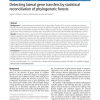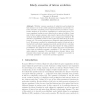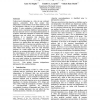25 search results - page 5 / 5 » Maximum Likelihood of Evolutionary Trees Is Hard |
102
Voted
BMCBI
2005
14 years 11 months ago
2005
Background: Distance-based methods are popular for reconstructing evolutionary trees thanks to their speed and generality. A number of methods exist for estimating distances from ...
102
Voted
BMCBI
2010
14 years 11 months ago
2010
Background: To understand the evolutionary role of Lateral Gene Transfer (LGT), accurate methods are needed to identify transferred genes and infer their timing of acquisition. Ph...
BMCBI
2010
14 years 11 months ago
2010
Background: The incorporation of annotated sequence information from multiple related species in commonly used databases (Ensembl, Flybase, Saccharomyces Genome Database, Wormbase...
RECOMB
2005
Springer
15 years 12 months ago
2005
Springer
Whether common ancestors of eukaryotes and prokaryotes had introns is one of the oldest unanswered questions in molecular evolution. Recently completed genome sequences have been u...
APBC
2004
15 years 1 months ago
2004
Undiscovered relationships in a data set may confound analyses, particularly those that assume data independence. Such problems occur when characters used for phylogenetic analyse...



